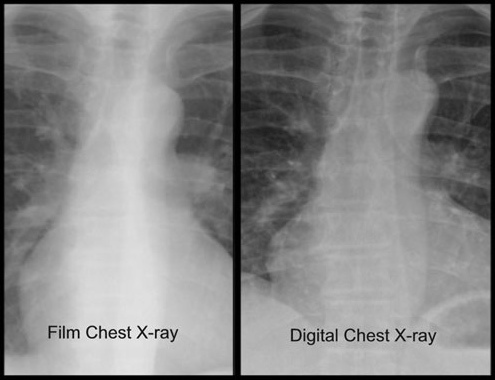Computer-aided detection of cancer
Computer software that enhances plain chest
x-rays and identifies areas that need further work-up is now being tested in
China and could be available in the United States in the next year or
two.

Computer software that enhances plain chest x-rays and identifies areas
that need further work-up is now being tested in China and could be available in
the United States in the next year or
two.
Perhaps more importantly, its developers are hopeful that, if the new technology gets U.S. approval, insurance companies will be willing to foot the bill.
The computer-aided detection (CAD) tool by Kodak was designed to improve lung cancer screening.
According to David Faller, general manager of CAD Business in Kodak’s Health Group, the only affordable way to test large populations for lung cancer at the current time is by chest x-ray, which can miss small or difficult to find lesions behind ribs.
Although CT scans solve these problems, they take up to 20 minutes to perform, more than an hour to analyze, and are too expensive and time-consuming to be used in the general population.
Faller said Kodak’s new product enhances a normal x-ray in under a minute, allowing radiologists to see if there are “areas of interest” that require more extensive work-up. While there are other x-ray/CAD screening tools on the market, Faller said the Kodak system was faster, could be added to current equipment, and analyzes images in a way that allows radiologists to integrate the additional pictures into their normal workflow.
Kodak is testing the system in China, and it will be marketed there in early 2007, along with CAD-enhanced full-field digital mammography systems that can integrate with GE and Siemens mammography machines and a CAD improvement for bone mineral density testing that can analyze a digital x-ray of a woman’s hand. Kodak plans to bring all three products to the United States as soon as possible, company representatives said.
Kodak’s digital mammography is reported to increase early detection of potential breast cancer by almost 40% — bringing detection forward almost 15 months. You might hope the whole package gets here as soon as possible — including approval by the always beloved insurance industry.
Perhaps more importantly, its developers are hopeful that, if the new technology gets U.S. approval, insurance companies will be willing to foot the bill.
The computer-aided detection (CAD) tool by Kodak was designed to improve lung cancer screening.
According to David Faller, general manager of CAD Business in Kodak’s Health Group, the only affordable way to test large populations for lung cancer at the current time is by chest x-ray, which can miss small or difficult to find lesions behind ribs.
Although CT scans solve these problems, they take up to 20 minutes to perform, more than an hour to analyze, and are too expensive and time-consuming to be used in the general population.
Faller said Kodak’s new product enhances a normal x-ray in under a minute, allowing radiologists to see if there are “areas of interest” that require more extensive work-up. While there are other x-ray/CAD screening tools on the market, Faller said the Kodak system was faster, could be added to current equipment, and analyzes images in a way that allows radiologists to integrate the additional pictures into their normal workflow.
Kodak is testing the system in China, and it will be marketed there in early 2007, along with CAD-enhanced full-field digital mammography systems that can integrate with GE and Siemens mammography machines and a CAD improvement for bone mineral density testing that can analyze a digital x-ray of a woman’s hand. Kodak plans to bring all three products to the United States as soon as possible, company representatives said.
Kodak’s digital mammography is reported to increase early detection of potential breast cancer by almost 40% — bringing detection forward almost 15 months. You might hope the whole package gets here as soon as possible — including approval by the always beloved insurance industry.
Posted: Fri - November 3, 2006 at 08:11 AM